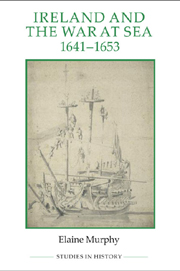Book contents
- Frontmatter
- Contents
- List of figures, maps and tables
- Acknowledgements
- Abbreviations
- Glossary
- Map 1 Ireland, 1641–9: principal ports and locations
- Map 2 The British Isles, 1641–9: principal ports and locations
- Map 3 The British Isles and Europe, 1641–9: principal ports and locations
- Introduction
- PART I The War at Sea, 1651–1653
- Part II Navies and the Conduct of the War at Sea
- Appendices
- Bibliography
- General index
- Index of ships
Introduction
Published online by Cambridge University Press: 05 April 2013
- Frontmatter
- Contents
- List of figures, maps and tables
- Acknowledgements
- Abbreviations
- Glossary
- Map 1 Ireland, 1641–9: principal ports and locations
- Map 2 The British Isles, 1641–9: principal ports and locations
- Map 3 The British Isles and Europe, 1641–9: principal ports and locations
- Introduction
- PART I The War at Sea, 1651–1653
- Part II Navies and the Conduct of the War at Sea
- Appendices
- Bibliography
- General index
- Index of ships
Summary
In September 1656 Henry Cromwell, the head of the English administration in Ireland, wrote from Dublin to the admiralty in London about the activities of pirates in the Irish Sea. He complained that ‘severall Pyratts whoe are newly come uppon these Coastes, and for want of a sufficient guarde of shipps of force they doe us much mischeiff; they have alreadie taken many men tradeing hither; and indeed will wholly spoyle our trade if you doe not apply a speedie remedie’. His complaint echoes one made fourteen years earlier that warned of the dangers posed by Wexford privateers who ‘profess openly they will make another Dunkirk and infest us in all the parts of the coasts of the kingdom’. For much of the seventeenth century piracy and privateering was a major problem for the English navy off the Irish coast. The nature of the danger varied over time, from pirates operating from Irish harbours, especially in the first two decades of the century, to privateers and ‘Barbary corsairs’ from Europe and North Africa. In the 1640s and early 1650s, however, the maritime situation in Ireland changed markedly. The outbreak of a rebellion in Ireland, followed by civil war in England, led to an increase in, and more complex, naval activity and privateering enterprises operating on the Irish seaboard, whether flying under the colours of confederates, parliamentarians or royalists. Instead of dealing with relatively isolated incidents of piracy, the English navy was confronted with a largescale well-organised privateering organisation based in some of the principal port towns in Ireland.
- Type
- Chapter
- Information
- Ireland and the War at Sea, 1641–1653 , pp. 1 - 10Publisher: Boydell & BrewerPrint publication year: 2012

